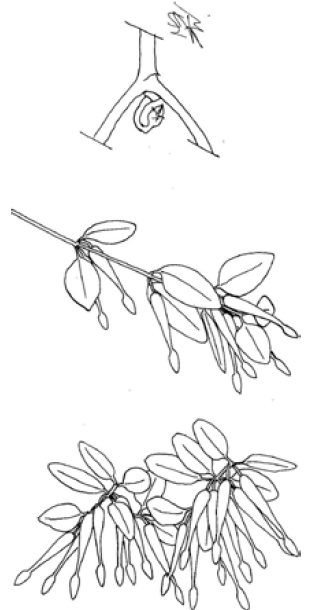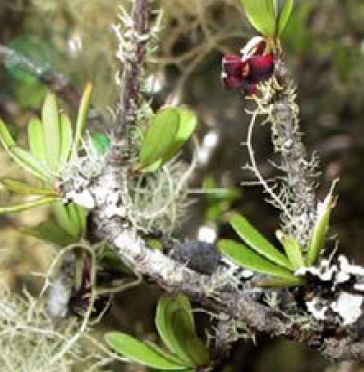 |
| Peraxilla tetrapetala. Illustration: Eleanor Burton. |
Trip Report – 1 November 2014 : Gibbs Covenant, Eastbourne
This trip, in the most recent addition to East Harbour Regional Park, was rescheduled from 1 March because of poor weather.
Before setting off up the hill, I introduced participants to the property and talked about his efforts with the propagation of a red mistletoe on the property. This 12 ha QEII covenant was established in 1994 to protect an area of predominantly black beech forest, characteristic of the eastern hills of Wellington Harbour, with its focus on a long-established red mistletoe,
Peraxilla tetrapetala. Efforts to propagate this plant begin in May when the mature fruit drop. A large net is strung up under the plant and checked regularly for fruit – a good harvest being about 70 a week during the peak fall. Each seed is squeezed out of the pericarp with its sticky adhesive and placed on small beech branches (max. 5 mm diameter) to await germination and eventual growth of a ‘root’. Germination is high (90%) but establishment to the point of producing a leaf is not (maybe 0.01%). Thus after fifteen years of trying, there are no more than five successful multi-branched ‘seedlings’ on their way to flowering maturity. As luck would have it, the most successful was right behind the house on a small sapling beech which itself succumbed last season after the mistletoe had a bumper flowering season and over-taxed the host completely. The BotSoc party unfortunately pre-empted the main flowering season this year, but a few red flowers on the day indicated the scale of the glory that was to come. A highlight was the visit of a tui, seen impatiently tweaking some of the early blooms. The party enjoyed a glorious day, working their way to the summit of the ridge for lunch, then along the ridge to join the Muritai Park Track back to Eastbourne. Several of the plants on the list prepared by Pat Enright for the covenant were in flower, ranging from the tiny near-black
Pittosporum divaricatum, to broad sprays of white
Olearia rani which is almost in mast-year mode.
 |
| Drymoanthus flavus. Photo: Sunita Singh. |
Orchids, twenty of which are recorded for the covenant, needed a careful search. Both species of Drymoanthus were in flower, some
Pterostylus banksii still with flower heads, with
Gastrodia cunninghami beginning to rise from the earth. Apart from the tui, the birdlife encountered included rifleman, fantail, grey warbler and kereru. Pest trapping was noted along the tracks in the covenant, with continuously set Timms traps for possums (10), and peanut-butter-baited Victor rat traps in tunnels (34) which kill mice, rats, stoats, weasels, and small hedgehogs, allowing annual assessment of numbers to be kept. This season, despite a massive beech mast year in November 2013, the numbers of rodents was kept to a minimum throughout the winter by the combined effort of GWRC staff and MIRO volunteers, with the result that birds have not suffered unduly, and the germination of black beech seedlings on the forest floor has been absolutely phenomenal – coming up throughout the covenant like a cress garden. The main pest plants monitored in the covenant are climbing Asparagus, boneseed and the odd
Pinus seedling.
 |
Pittosporum divaricatum. Photo: Sunita Singh.
|
Participants : Bev Abbott, Peter Beveridge, Helen Bichan, Eleanor Burton, Gavin Dench, Pat Enright, George Gibbs (leader/ scribe), Ian & Jill Goodwin, Ann, Claire & Meg Graeme, Bryan Halliday, Chris Hopkins, Chris Horne, Jane Humble, Archie & Lynsie Kerr, Rodney Lewington, Chris Moore, Syd Moore, Allan Munro, Phil Parnell, Mick Parsons, Leon Perrie, Lynne Pomare, Bruce & Viv Sampson, Lara Shepherd, Darea Sherratt, Sunita Singh, Julia Stace, Carol West.

 Site Index
Site Index







 Site Index
Site Index





